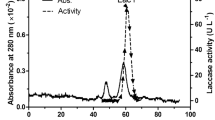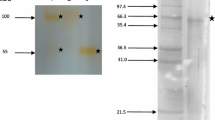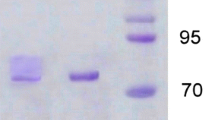Abstract
A laccase was purified from Trametes hirsuta. This laccase was classified as a “white” or “yellow” laccase. pH 2.4 was optimal for the oxidation of ABTS and pH 2.5 for DMP. DMP oxidation was optimal at 85°C. The half-life of this laccase was 70 min at 75°C, and 5 h at 65°C. Non-phenolic dyes, such as Methyl Red, were oxidized by purified laccase without mediators. The enzyme was not inhibited by Cu2+, Mn2+, or EDTA. These are atypical laccase characteristics that make it a good candidate for theoretical and applied research.





Similar content being viewed by others
References
Alexandre G, Zhulin IB (2000) Laccases are widespread in bacteria. Trends Biotechnol 18:41–42
Baldrian P (2006) Fungal laccases-occurrence and properties. FEMS Microbiol Rev 30:215–242
Berka RM, Schneider P, Golightly EJ, Brown SH, Madden M, Brown KM, Halkier T, Mondorf K, Xu F (1997) Characterization of the gene encoding an extracellular laccase of Myceliophthora thermophila and analysis of the recombinant enzyme expressed in Aspergillus oryzae. Appl Environ Microbiol 63:3151–3157
Chefetz B, Chen Y, Hadar Y (1998) Purification and characterization of laccase from Chaetomium thermophilium and its role in humification. Appl Environ Microbiol 64:3175–3179
Ducros V, Brzozowski AM, Wilson KS, Brown SH, Ostergaard P, Schneider P, Yaver DS, Pedersen AH, Davies GJ (1998) Crystal structure of the type-2 Cu depleted laccase from Coprinus cinereus at 2.2 Å resolution. Nature Struct Biol 5:310–316
Hadzhiyska H, Calafell M, Gibert JM, Dagà JM, Tzanov T (2006) Laccase-assisted dyeing of cotton. Biotechnol Lett 28:755–759
Johannes C, Majcherczyk A (2000) Laccase activity tests and laccase inhibitors. J Biotechnol 78:193–199
Jordaan J, Pletschke BI, Leukes WD (2004) Purification and partial characterization of a thermostable laccase from an unidentified basidiomycete. Enzyme Microb Technol 34:635–641
Leontievsky A, Myasoedova N, Pozdnyakova N, Golovleva L (1997) ‘Yellow’ laccase of Panus tigrinus oxidizes non-phenolic substrates without electron-transfer mediators. FEBS Lett 413:446–448
Leontievsky AA, Myasoedova NM, Baskunov BP, Pozdnyakova NN, Vares T, Kalkkinen N, Hatakka AI, Golovleva LA (1999) Reactions of blue and yellow fungal laccases with lignin model compounds. Biochemistry (Moscow) 64:1150–1156
Litthauer D, Vuuren MJV, Tonder AV, Wolfaardt FW (2007) Purification and kinetics of a thermostable laccase from Pycnoporus sanguineus (SCC 108). Enzyme Microb Technol 40:563–568
Lorenzo M, Moldes D, Couto SR, Sanroman MA (2005) Inhibition of laccase activity from Trametes versicolor by heavy metals and organic compounds. Chemosphere 60:1124–1128
Mansur M (2003) The white-rot fungus Pleurotus ostreatus secretes laccase isozymes with different substrate specificities. Mycologia 95:1013–1020
Mayer AM, Staples RC (2002) Laccase: new functions for an old enzyme. Phytochemistry 60:551–565
Min KL, Kim YH, Kim YW, Jung HS, Hah YC (2001) Characterization of a novel laccase produced by the wood-rotting fungus Phellinus ribis. Arch Biochem Biophys 392:286–297
Miyazaki K (2005) A hyperthermophilic laccase from Thermus thermophilus HB27. Extremophiles 9:415–425
Palmieri G, Giardina P, Bianco C, Scaloni A, Capasso A, Sannia G (1997) A novel white laccase from Pleurotus ostreatus. J Biol Chem 272:31301–31307
Pozdnyakova NN, Rodakiewicz-Nowak J, Turkovskaya OV (2006a) Catalytic properties of yellow laccase from Pleurotus ostreatus D1. J Mol Catat B-Enzym 30:19–24
Pozdnyakova NN, Turkovskaya OV, Yudina EN, Rodakiewicz-Nowak Y (2006b) Yellow laccase from the fungus Pleurotus ostreatus D1: purification and characterization. Appl Biochem Microbiol 42:56–61
Tong PG, Hong YZ, Xiao YZ, Zhang M, Tu XM, Cui TJ (2007) High production of laccase by a new basidiomycete, Trametes sp. Biotechnol Lett 29:295–301
Wang HX, Ng TB (2004) A novel laccase with fair thermostability from the edible wild mushroom (Albatrella dispansus). Biochem Biophys Res Commun 319:381–385
Wang L, Yan WC, Huang F, Gao PJ, Chen JC (2008) Function of the iron-binding chelator produced by Coriolus versicolor in lignin biodegradation. Sci China Ser C 51:214–221
Acknowledgments
The authors are grateful to Dr. Roberta Greenwood for her assistance in editing this manuscript. This study was supported by the National science Foundation of China (Grant Nos. 30371136 and 30871985).
Author information
Authors and Affiliations
Corresponding author
Rights and permissions
About this article
Cite this article
Haibo, Z., Yinglong, Z., Feng, H. et al. Purification and characterization of a thermostable laccase with unique oxidative characteristics from Trametes hirsuta . Biotechnol Lett 31, 837–843 (2009). https://doi.org/10.1007/s10529-009-9945-0
Received:
Revised:
Accepted:
Published:
Issue Date:
DOI: https://doi.org/10.1007/s10529-009-9945-0




